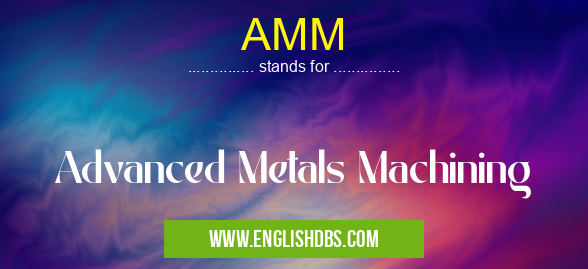What does AMM mean in UNCLASSIFIED
AMM stands for Advanced Metals Machining. It is a specialized field of machining that involves the use of advanced techniques and technologies to machine complex and high-precision components from various types of metals. AMM is widely employed in industries such as aerospace, automotive, and medical equipment manufacturing.

AMM meaning in Unclassified in Miscellaneous
AMM mostly used in an acronym Unclassified in Category Miscellaneous that means Advanced Metals Machining
Shorthand: AMM,
Full Form: Advanced Metals Machining
For more information of "Advanced Metals Machining", see the section below.
What is Advanced Metals Machining (AMM)?
AMM encompasses a range of processes, including:
-
Computer Numerical Control (CNC) Machining: Using computer-controlled machines to cut, drill, and shape metal components with high accuracy and precision.
-
Wire Electrical Discharge Machining (EDM): Utilizing an electrical discharge to erode and shape metal workpieces, creating complex geometries and intricate features.
-
Electrical Discharge Machining (EDM): Submerging the workpiece in a dielectric fluid and using an electrical discharge to remove material, enabling the production of complex shapes and fine details.
-
Laser Cutting: Employing a laser beam to cut and shape metal components, resulting in clean, precise cuts and minimal heat-affected zones.
-
Waterjet Cutting: Using a high-pressure stream of water mixed with abrasive particles to cut and shape metal, offering versatility and precision.
Benefits of Advanced Metals Machining
AMM offers numerous advantages over traditional machining methods, including:
-
Increased Accuracy and Precision: Advanced techniques ensure high levels of accuracy and precision, meeting the stringent requirements of industries like aerospace.
-
Complex Geometries: AMM allows for the creation of complex and intricate geometries that would be difficult or impossible to achieve with conventional machining.
-
Reduced Waste: Advanced processes minimize material waste, resulting in cost savings and improved sustainability.
-
Faster Production: Automated and efficient machining processes enable faster production times, meeting the demands of industries with high-volume requirements.
-
Versatility: AMM can be applied to a wide range of metals, including exotic alloys and hardened steels, expanding its applications in various industries.
Essential Questions and Answers on Advanced Metals Machining in "MISCELLANEOUS»UNFILED"
What is Advanced Metals Machining (AMM)?
Advanced Metals Machining (AMM) encompasses a range of specialized techniques used to machine advanced metallic materials, which possess unique properties that require tailored machining processes. These materials include high-strength alloys, titanium, and nickel-based superalloys. AMM employs precision cutting and forming methods to produce complex parts with tight tolerances and high surface finishes.
What are the benefits of using AMM?
AMM offers several advantages over conventional machining methods:
- Precision: AMM techniques provide exceptional accuracy and repeatability, enabling the production of intricate parts with tight tolerances.
- Efficiency: Advanced cutting tools and processes minimize machining time and reduce cycle times, resulting in increased productivity.
- Surface quality: AMM techniques produce parts with superior surface finishes, reducing the need for post-processing and improving component performance.
- Material utilization: AMM optimizes material usage by minimizing waste and maximizing material yield.
What industries use AMM?
AMM finds application in various industries, including:
- Aerospace: AMM is used to machine critical components for aircraft engines, landing gear, and structural components.
- Automotive: AMM is employed in the production of engine blocks, transmission gears, and other high-performance automotive parts.
- Medical: AMM is used to create precision surgical instruments, implants, and medical devices.
- Defense: AMM is utilized in the manufacturing of weapons systems, armor, and military equipment.
What are the challenges in AMM?
AMM presents several challenges:
- Material properties: Advanced metallic materials can be difficult to machine due to their high hardness and strength.
- Tool wear: Cutting tools used in AMM experience rapid wear, requiring frequent replacement and maintenance.
- Heat generation: Machining advanced metals generates significant heat, which must be effectively managed to maintain tool life and part quality.
What are the emerging trends in AMM?
The AMM industry is evolving with the following trends:
- Hybrid machining: Combining different machining processes, such as laser cutting and milling, to improve efficiency and part quality.
- Additive manufacturing integration: Utilizing 3D printing techniques to create complex geometries not achievable through traditional machining.
- Digital twin technology: Using virtual simulations to optimize machining processes and reduce waste.
Final Words: AMM is a crucial technology in modern manufacturing, providing advanced capabilities for machining complex metal components with high accuracy and precision. Its versatility and benefits make it essential for industries that demand high-quality and intricate metal parts. As technology continues to advance, AMM is poised to play an increasingly significant role in shaping the future of manufacturing.
AMM also stands for: |
|
| All stands for AMM |
